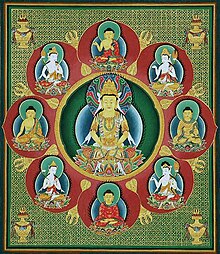Five wisdoms
| Part of a series on |
| Mahāyāna Buddhism |
|---|
 |
| Part of a series on |
| Tibetan Buddhism |
|---|
 |
The Five Wisdoms
Meaning and translations
Pañca-jñāna is rendered in English as: "five wisdoms," "five awarenesses," or "five pristine cognitions."[citation needed]
Interpretations
The Five Wisdoms are:
- Tathatā-jñāna, the wisdom of Suchness or Dharmadhatu, "the bare non-conceptualizing awareness" of Śūnyatā, the universal substrate of the other four jñāna;[2]
- Ādarśa-jñāna, the wisdom of "Mirror-like Awareness", "devoid of all dualistic thought and ever united with its 'content' as a mirror is with its reflections";[2][note 3] This type of wisdom is a transformation of the eighth consciousness, the Alayavijnana.
- Samatā-jñāna, the wisdom of the "Awareness of Sameness", which perceives the sameness, the commonality of or emptiness. Such undifferentiation gives rise to equality for all beings. Hence, it is also understood as the wisdom of equality or impartiality.[3]
- Pratyavekṣaṇa-jñāna, the wisdom of "Investigative Awareness", that perceives the specificity, the uniqueness of dharmas.[2] This type of wisdom is a transformation of the sixth consciousness, and is also known as the wisdom of specific knowledge or sublime investigation.[3]
- Kṛty-anuṣṭhāna-jñāna, the wisdom of "Accomplishing Activities", the awareness that "spontaneously carries out all that has to be done for the welfare of beings, manifesting itself in all directions".[2] This type of wisdom is created through the transformation of the five sensory consciousness.[3]
The Five Wisdoms "emerge through a transformation (parāvṛtti) of the eight consciousnesses at the moment of enlightenment".[2]
Five Dhyani Buddhas

The idea of the Five Wisdoms "underwent a considerable development" within
According to Bönpo teacher
The Five Wisdoms, and the accompanying Five Buddhas, are represented in Tibetan Buddhism by the "symbolic bone ornaments".
- the 'wheel-like' (Tib.: 'khor lo') 'crown ornament' (sometimes called 'crown jewel') (Tib.: gtsug gi nor bu), symbolic of Akshobhya and 'mirror-like pristine awareness' (Ādarśa-jñāna);
- 'earrings' (Tib.: rna cha) represent of Amitabhaand pristine awareness of discernment (Pratyavekṣaṇa-jñāna);
- 'necklace' (Tib.: mgul rgyan) symbolizing Ratnasambhava and pristine awareness of total sameness (Samatā-jñāna);
- 'bracelets' (Tib.: lag gdu) and 'anklets' (Tib.: gdu bu) as symbolic of Vairochanaand pristine awareness of the ultimate dimension of phenomena (Tathatā-jñāna);
- 'girdle' (Tib.: ske rags) symbolizing Amoghasiddhi and the accomplishing pristine awareness (Kṛty-anuṣṭhāna-jñāna);
The additional ornament spoken of in various texts related to Hevajra is ash from a cremation ground smeared on the body (Tib.: thal chen).[5]
See also
- Four Dharmadhātu
- Four ways of knowing
- Achintya Bheda Abheda
- Darśana
- Dhyani Buddhas
- Five Powers
- Mahabhuta
- Pancamakara
- Pancatattva
Notes
References
- ^ Rangjung Yeshe Dictionary
- ^ a b c d e f g Keown 2003, p. 209.
- ^ OCLC 1003080564.)
{{cite book}}: CS1 maint: location missing publisher (link) CS1 maint: others (link - ISBN 1-55939-176-6
- ^ ISBN 1-55939-210-X(alk.paper) p.493
- ^ refer CH, f. 66a6-b1; where CH = Kongtrul Lodrö Taé, Disclosing the Secret of the Invincible Vajra: Phrase by Phrase Commentary on the Hevajra Tantra Two Examinations (dPal kye'i rdo rje'i rgyud kyi rgyal po brtag pa gnyis pa'i tshig don rnam par 'grol ba bzhom med rdo rje'i gsang ba 'byed pa). Rumtex, Sikkim: Dharma Chakra Centre, 1981.
Sources
Published sources
- Kalupahana, David J. (1991), Buddhist Thought and Ritual, Paragon House
- Keown, Damien (2003), A Dictionary of Buddhism, Oxford University Press, ISBN 0-19-860560-9
- Thrangu Rinpoche (author) & Peter Roberts (translator) (1998). The Five Buddha Families and The Eight Consciousnesses. Boulder, CO, USA: Published by the Namo Buddha Seminar. Source: [1] Archived 2008-07-20 at the Wayback Machine (accessed: November 22, 2007)
Web-sources
- ^ a b c Lone Hansen (Shenphen Chödron), The Five Wisdoms Archived 2014-07-14 at the Wayback Machine
External links
- The Five Wisdoms: Talk five of six on the Buddhist Wisdom teachings. (transcribed talk), by FWBO's Ratnaghosa (accessed: Thursday, November 22, 2007)
